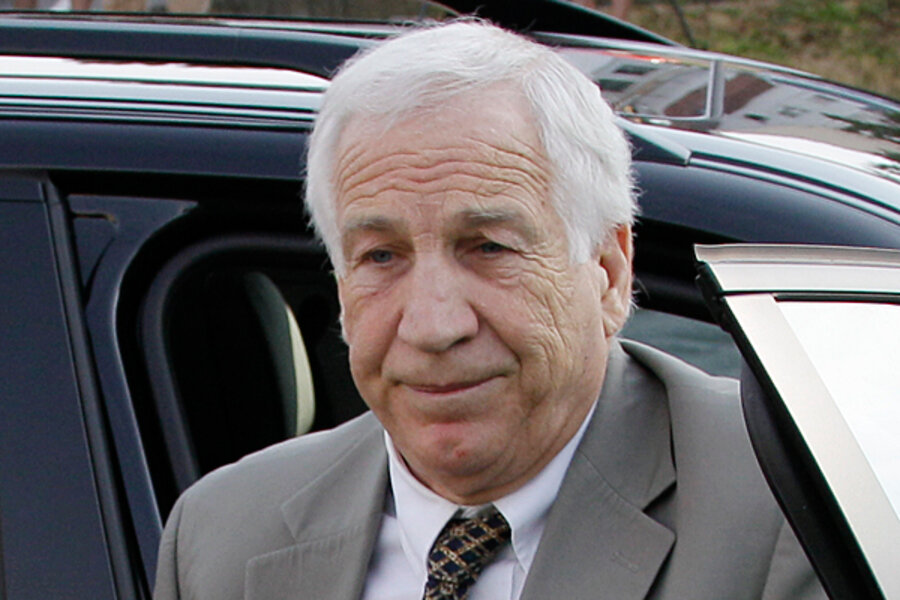Sandusky case: Can prosecutors explain long gap between abuse and charges?
Loading...
As the trial of Jerry Sandusky gets underway today in Bellefonte, Pa., the prosecution's case against the former Penn State assistant coach could turn on its ability to explain the almost 15-year lapse between the alleged period of sexual abuse and today.
While the lead prosecutor on Monday promised witnesses would provide credible testimony, state law prohibits prosecutors from putting experts on the stand to explain why victims of sexual abuse often wait years before alerting the authorities.
Mr. Sandusky, who is charged with abusing 10 boys over 15 years, faces 52 criminal counts related to the abuse. He says he is not guilty of the charges.
Eight of the alleged victims, who are now all adults, will testify, says Senior Deputy Attorney General Joseph McGettigan, the lead prosecutor in the case. In opening remarks Monday morning that lasted 50 minutes, Mr. McGettigan said the majority of Sandusky’s victims did not have fathers so became dependent on him through his children’s charity, The Second Mile.
McGettigan characterized the charity as “the perfect environment for the predatory pedophile,” and said Sandusky established a pattern of grooming the victims through gifts and attention, followed by sexual abuse, some of which McGettigan said happened in the on-campus facilities of the Penn State football team.
Despite the nearly 15-year time window between today and when victims in the trial say their abuse took place, McGettigan said the witnesses would deliver credible testimony.
“They are real people with real experience. You will know they were violated,” he said.
The oldest victim is now 28.
The time lapse in the Sandusky case is not uncommon, however it does provide the defense a greater opportunity to challenge the credibility of the victims and to find corroborating evidence, says Richard Frankel, a law professor at Drexel University’s Earle Mack School of Law in Philadelphia.
The defense has to convince the jury why the alleged victims didn’t come forward earlier if they could have, Mr. Frankel says. In doing so, they will drill down on the specific details of the allegations because “the longer the time passes, the more memories that are in the back of their head aren’t recorded accurately,” he says.
Each alleged victim is expected to provide a reason why they waited until last year to report the abuse. Jules Epstein, a law professor at the Widener University School of Law in Chester, Pa., says it is “certainly not unheard of” in child abuse cases for victims to wait until they are adults to say they were abused. Mr. Epstein says there are many reasons why, but the most common is that the abuse is “sometimes done in the guise of love” so victims remained unaware that it was wrong.
Other common reasons are shame and the fear of retaliation by the abuser.
State law forbids testimony from experts, like a psychologist or a social worker, to give jurors these reasons directly. Epstein says it is too soon to tell if that omission will harm the prosecution’s case.
“It depends on the knowledge of each of the 12 jurors. If they get [why victims often wait], then it’s no harm, no foul,” he says. “But if they truly don’t get it and are thinking, ‘If this happened to me, I’d be shouting from the rooftops,’ then it’s a problem.”
Another area for the defense to explore is to determine if any of the victims are motivated by money, or if their background – a history of drug or alcohol abuse, for example – suggests they can’t be trusted.
In his opening statement Monday, defense attorney Joseph Amendola pointed out that several of the witnesses have their own lawyers and one has filed a civil complaint, suggesting they have ulterior motives beyond bringing Sandusky to justice.
“It is rare, it is absolutely, totally unusual for an alleged victim to have an attorney beside them, representing them … these young men have a financial interest,” Mr. Amendola said.
The civil complaint is pending until a verdict in the criminal case is reached.
Many witnesses besides the alleged victims are expected to take the stand for the prosecution, McGettigan said. They include former Second Mile employees, experts with children’s service agencies, and Mike McQueary, the former Penn State assistant coach who says he witnessed Sandusky raping a boy in the team’s shower facilities in February 2001.
McGettigan told jurors they would also view hard evidence that will determine Sandusky’s predatory scheming, such as love letters to the victims from Sandusky and a list of Second Mile children with notations about what they looked like and if they had parents. The prosecution is also allowed to use media interviews Sandusky gave since his November 2011 arrest. When asked by Bob Costas of NBC if he was sexually attracted to young boys, Sandusky said, “I enjoy young people. I love to be around them. But no, I’m not sexually attracted to young boys.”








